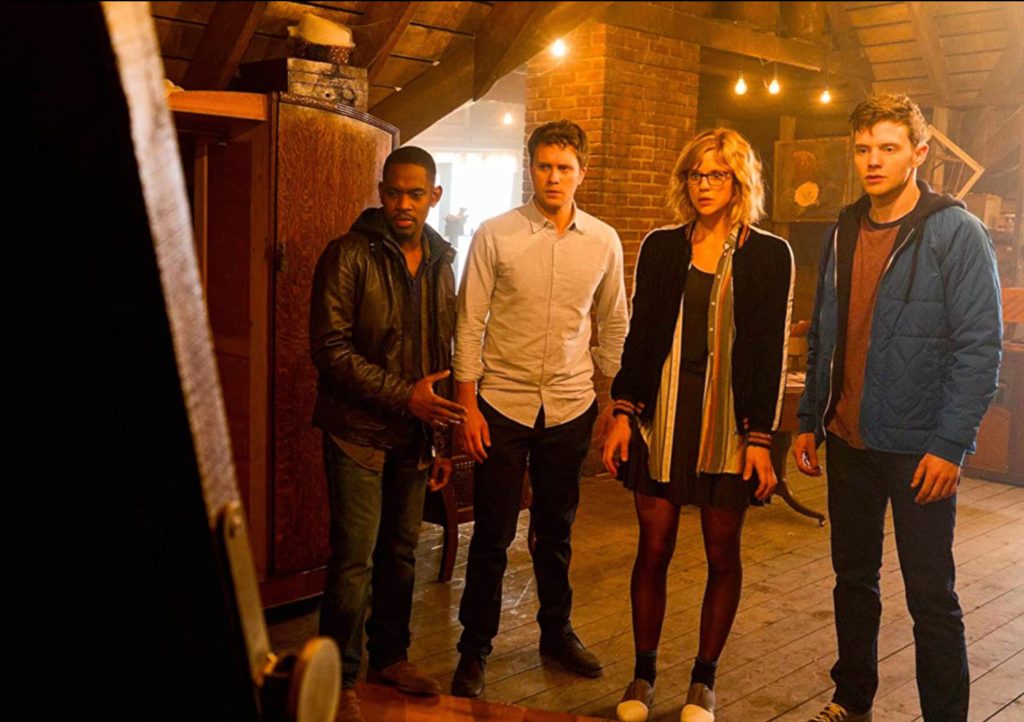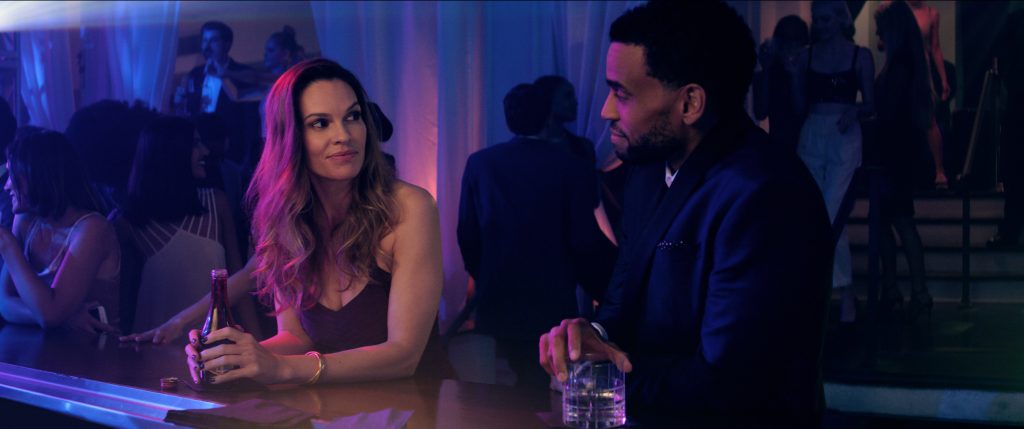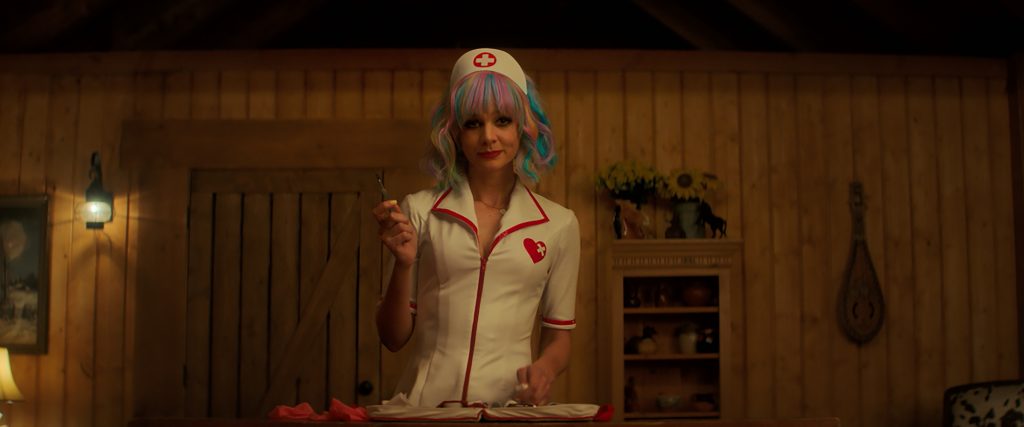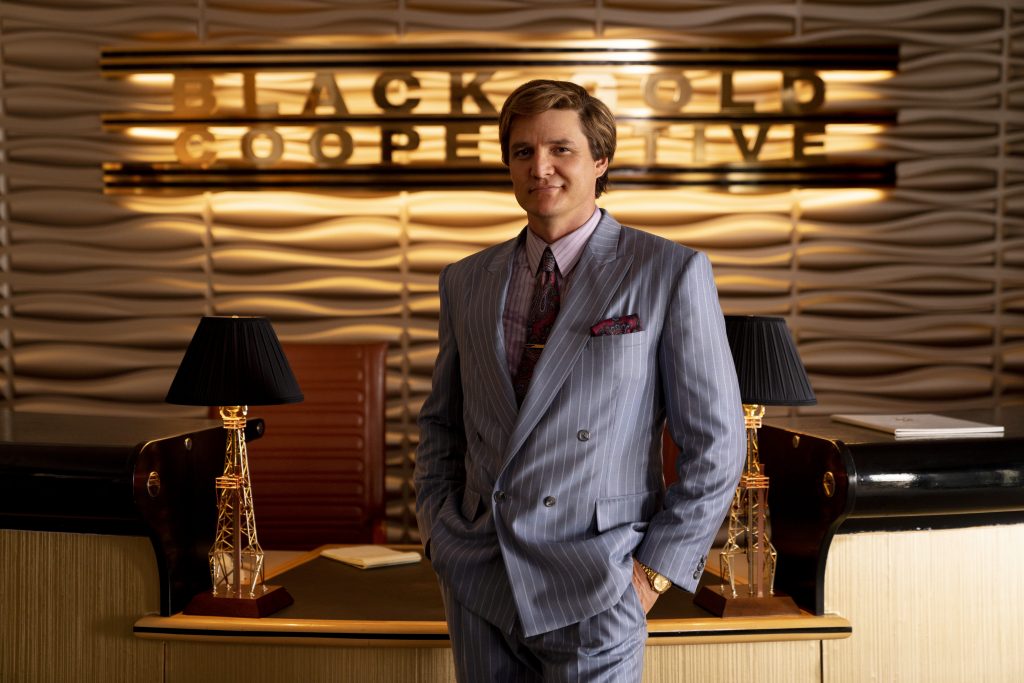December 29, 2020
by Carla Hay
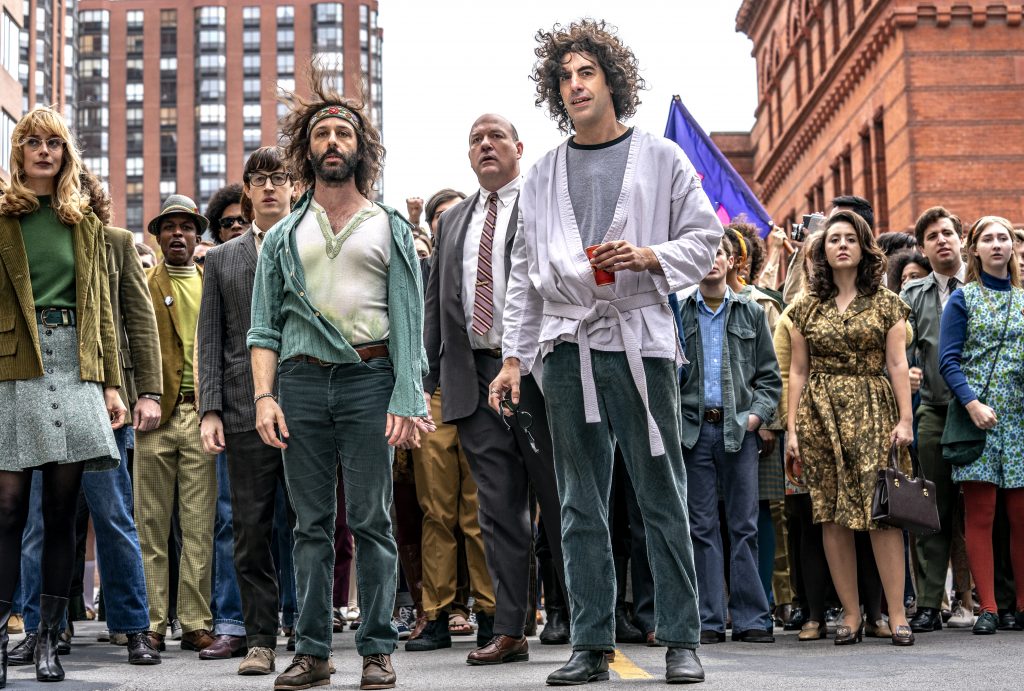
Directed by Aaron Sorkin
Culture Representation: Taking place from 1968 to 1970, primarily in Chicago and briefly in Washington, D.C., the dramatic film “The Trial of the Chicago 7” features a predominantly white cast of characters (with some African Americans) representing the middle-class and upper-class.
Culture Clash: Eight men accused of inciting riots during the 1968 Democratic National Convention in Chicago go on trial in a case that exemplified the conflicts between the “establishment government” and “radical activists.”
Culture Audience: “The Trial of the Chicago 7″ will appeal primarily to people interested in dramatic interpretations of real political and legal events in American history during the Vietnam War, with the stories being unapologetically sympathetic to progressive liberal politics.
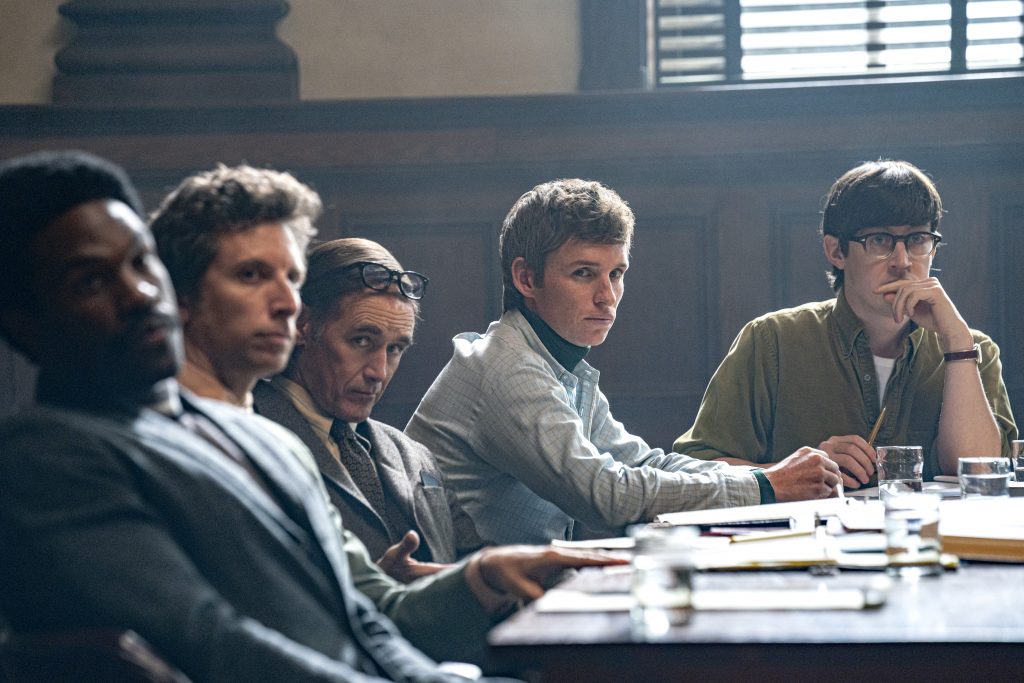
“The Trial of the Chicago 7” might as well have been called “The Showcase of Sacha Baron Cohen.” Although the movie has a big ensemble cast, he ends up stealing the show in his portrayal of left-wing activist Abbie Hoffman. This elevation of Hoffman as the “star” of the story is entirely by design, since “The Trial of Chicago 7” writer/director Aaron Sorkin has a reputation for not allowing actors to improvise in the movies that he writes and directs.
Taking place mostly in Chicago from 1968 to 1970, amid protests against the controversial Vietnam War, “The Trial of the Chicago 7” seems entirely calculated to win as many prestigious awards as possible. “The Trial of Chicago 7” exposes those ambitions too blatantly for it to feel like a truly immersive cinematic experience. The results are that viewers will feel constantly reminded that they’re watching showboat performances and re-enactments rather than being transported to experiencing the genuine emotions of the real-life people involved in this story.
Sorkin (who won an Oscar for writing the 2010 movie “The Social Network”) delivers the type of articulate and verbose screenplay that people would expect from the Emmy-winning former showrunner of “The West Wing.” “The Trial of Chicago 7” has got plenty of sociopolitical commentary that makes conservatives look like villains, and liberals look like heroes. (Sorkin is an outspoken liberal in real life.) There’s also a lot of snappy dialogue with witty one-liners and feisty arguments. And the film editing, which jumps back and forth in time, keeps the tone and pace of the movie very lively.
The trial is obviously the center of the story, but the movie’s non-chronological scenes alternate between showing the trial, showing events leading up to the trial, and showing what happened outside of the courtroom during the six months that the trial took place. It’s a lot to cram into a feature-length movie—”The Trial of the Chicago 7″ clocks in at 129 minutes—so some defendants get a lot more screen time and backstories than others. For the most part, the dramatic retelling of this true story works. However, there are a few scenes that were obviously fabricated for the movie, while the movie also leaves out a lot of uncomfortable truths.
“The Trial of the Chicago 7” begins with a brief overview of how the U.S. was affected by the Vietnam War, which was declared by President Lyndon Johnson (a moderate Democrat) in 1965 to save Vietnam from Communism. The Vietnam War escalated into a conflict that American protesters believed was a pointless and expensive war. As thousands of people died in the war, young men in America tried to avoid being drafted into the military. And millions of Americans, especially many of college age, became conscientious war protestors. Vietnam War advocates labeled anti-war protesters as “radicals” and “unpatriotic.”
In 1968, Johnson did not seek re-election. Hubert Humphrey, a former U.S. Senator from Minnesota, became the U.S. presidential nominee for the Democratic Party that year. Humphrey’s conservative Republican opponent was Richard Nixon, a former U.S. vice president under Dwight D. Eisenhower. Nixon would go on to win the presidential election in 1968 and was inaugurated in January 1969.
But before that happened, the Democratic National Convention (DNC) in Chicago in August 1968 became a flashpoint for increasing civil unrest over the Vietnam War and the civil rights movement. Thousands of protestors gathered in Chicago, resulting in violent clashes between law enforcement (Chicago police and the National Guard) and protestors. The riots lasted for two days and ended with 11 people dead, an untold number of people wounded, and thousands of people arrested.
In April 1968, U.S. Congress passed the Rap Brown Law, to make it illegal for people who live outside a community to incite confrontations in a community where they don’t live. It was intended as an anti-riot law, but critics of the law believed its was just the government’s response to people who wanted to organize widespread protests against the Vietnam War and racial injustice. People who advocated for the law believed that it was necessary to help prevent violence during protests.
Johnson and his administration’s U.S. Attorney General Ramsey Clark decided that there wasn’t enough evidence to federally prosecute anyone for the violence that happened at the 1968 DNC, which ended up being used as an example of how divided America was over the Vietnam War. However, Johnson’s presidential successor Nixon, who ran for U.S. president on a platform to restore “law and order,” had other ideas on how to deal with the chief protestors who were at the 1968 DNC. The Rap Brown Law was about to be enforced, and certain protestors were going to be prosecuted for it.
One of the early scenes in the movie takes place in 1969, in Washington, D.C., by depicting a meeting called by John Mitchell (played by John Doman), the U.S. attorney general appointed by Nixon. In the meeting with Mitchell are attorneys Richard Schultz (played by Joseph Gordon-Levitt), Thomas Foran (played by J.C. MacKenzie) and Howard Ackerman (played by Damien Young), who is a special adviser to Mitchell. Mitchell tells Schultz and Moran that he intends to use the Rap Brown Law to prosecute the leaders of some of the anti-Vietnam War groups who were at the 1968 DNC.
Schultz, who is a very by-the-book young attorney, can’t understand why this prosecution should take place, because Johnson declined to federally prosecute anyone for the 1969 DNC riots because of a lack of evidence. Mitchell essentially says that he doesn’t care, and he agrees with Nixon in wanting to make an example out of these “radical” left-wing leaders. Mitchell also strongly hints that he has a grudge against Clark (played by Michael Keaton), because Mitchell believes that Clark disrespected him in the transition process when the Nixon administration took over from the Johnson administration.
Mitchell decides that Schultz will be the lead prosecutor in the case, with Foran also on the prosecution team. Schultz is very reluctant to take the job because he feels that he doesn’t have enough experience in handling such a big, high-profile case. However, Mitchell insists that Schultz is the best person for the job and convinces Schultz to be the lead prosecutor in the case. It’s not said outright, but viewers can infer that Mitchell chose Schultz because Mitchell probably felt that Schultz’s youth and inexperience would make it easier for the U.S. government to manipulate Schultz.
On March 20, 1969, eight left-wing group leaders were indicted for conspiracy to cross state lines to incite the 1968 DNC riots, among other charges. Their joint trial began in Chicago on September 24, 1969. Presiding over the trial was Judge Julius Hoffman (played by Frank Langella) of the U.S. District Court for the Northern District of Illinois.
The eight men on trial were:
- Tom Hayden, a former president and prominent leader of the activist group Students for a Democratic Society (SDS).
- Rennie Davis (played by Alex Sharp), another prominent SDS leader, who is depicted in the movie as Hayden’s best friend.
- Abbie Hoffman (played by Baron Cohen), co-founder of the Youth International Party, also known as the Yippies, a group advocating for counterculture politics and lifestyles.
- Jerry Rubin (played by Jeremy Strong), co-founder the Youth International Party.
- David Dellinger (played by John Carroll Lynch), a prominent member of the National Mobilization Committee to End the War in Vietnam (The MOBE), a conference of anti-Vietnam War groups.
- John Froines (played by Danny Flaherty), a MOBE member who was eventually acquitted of all charges in the trial.
- Lee Weiner (played by Noah Robbins), a MOBE member who was eventually acquitted of all charges in the trial.
- Bobby Seale (played by Yayha Abdul-Mateen II), co-founder of the Black Panther Party, an activist group against racial discrimination of black people.
The attorneys for the defendants who are portrayed in the movie are William Kunstler (played by Mark Rylance) and his colleague Leonard Weinglass (played by Ben Shenkman). Kunstler is portrayed as passionate supporter of civil liberties who is fairly even-tempered except when his patience is pushed to the limits. On the prosecution side, Schultz’s courtroom style is more conventional than Kunstler’s style. The supporting lawyers on each side (Foran for the prosecution, Weinglass for the defense) don’t have as much screen time or personality in the movie as the lead attorneys.
And from the beginning, there were problems with Seale being on trial in the first place. He’s depicted as very outspoken in trying to distance himself from the other defendants, by saying that he didn’t even know most of them and certainly didn’t conspire with them. Seale was only in Chicago for four hours to give a speech on one of the days of the 1968 DNC. And in the portions of the trial that are depicted in the movie, Seale vehemently objected on his own behalf because his attorney Charles Garry wasn’t in the courtroom because Garry was in Oakland, California, having surgery.
“The Trial of the Chicago 7” portrays the biggest villain in the courtroom as Judge Hoffman, who doesn’t try to hide his bias against the defendants. The movie also shows that the judge had a racist side in how he treated Seale differently from the other defendants. Judge Hoffman didn’t seem to care that Seale’s attorney wasn’t present during the trial. In a harrowing scene, after Seale was jailed for contempt of court, for angrily talking back to the judge, the Black Panthers leader experienced police brutality from cops who were basically given permission by the judge to do whatever they wanted to Seale to teach him a lesson.
After being physically assaulted by these cops, Seale was paraded back in the courtroom in handcuffs and chains, with a gag on his mouth. Although the white defendants also received several contempt of court citations, they were not physically assaulted and humiliated in the way that Seale was during the trial. The movie depicts several people, including lead attorneys Kunstler and Schultz, being shocked and outraged at how Seale was mistreated, but not doing much about it.
In real life, several of the white defendants were heavily involved in the civil rights movement and fighting against racial discrimination. However, the movie focuses more on the white defendants’ anti-Vietnam War protests as their main activism. Racism is mostly used in the movie as a plot device for Seale’s storyline.
Early on in the trial, Kunstler advises Fred Hampton (played by Kelvin Harrison Jr.), the leader of the Chicago chapter of the Black Panthers, to tell the Black Panthers who are gathered in the courtroom to not sit together. The implication is clear: A bunch of black people sitting together is considered a “threat,” while it’s perfectly okay for white people to sit together. Hampton understands why this request was made, and he tells the Black Panthers in the courtroom to spread out and to take off their hats—not because he wants to be subservient to white racism but because he knows that Seale has a better chance of being acquitted if the Black Panthers in the courtroom aren’t perceived as a “threat.”
And once Seale is out of the picture (a mistrial was declared for Seale on November 6, 1969), the issue of racism also disappears from the movie. Seale’s departure leaves seven remaining defendants, and then the movie really becomes the Abbie Hoffman Show. “The Trial of Chicago 7” makes wisecracking Hoffman out to be the “class clown” who’s also the “hero” of the movie. Hoffman clashes with Hayden outside of the courtroom, so that the movie can show that these seven defendants didn’t have the united front that the public thought they had at the time.
Hoffman’s sarcastic persona is often expressed in how he talks back to the judge. In an early part of the trial, Judge Hoffman announces in court that the record should reflect that he’s not related to Abbie Hoffman. In response, defendant Hoffman shouts out in mock indignation, “Father!”
It’s one of many outbursts that Hoffman makes in the courtroom during the trial. Hoffman also makes fun of the judge when the judge repeatedly and mistakenly uses the name Derringer when referring to defendant Dellinger. Hoffman suggests that the judge remember that Derringer is the brand name of a gun.
While out on bail, the movie shows several scenes of Hoffman on stage in darkly lit places filled with audiences eager to hear what he has to say. The movie frames these scenes as if Hoffman is a stand-up comedian in a nightclub, as he delivers jokes and one-liners about what it’s like to be on trial and what a farce he thinks the trial is. Judge Hoffman is often mentioned in Abbie Hoffman’s rants against the system.
Rubin is portrayed as Hoffman’s loyal sidekick who is effective in a way that calls less attention to himself than Hoffman’s more loudmouthed techniques. However, Hoffman and Rubin’s fiery brand of activism and shenanigans outside the courtroom garner enough media attention that Judge Hoffman wants to sequester the jury. It’s also implied that Hayden resented all the media attention that Hoffman was getting, and that was part of the reason why Hoffman and Hayden clashed so much behind the scenes during the trial.
Although “The Trial of Chicago 7” makes Hoffman the comic relief in the film, the movie also portrays him not as a buffoon but as the savviest one of the defendants. He’s the first one to declare in a meeting with the other defendants, “This is a political trial. It [the outcome] was already decided for us,” while Hayden still wants to believe that the defendants will get a fair trial.
Hayden is less inclined to believe that there are larger political motives behind the trial. “I would love it if the trial wasn’t about us, but I assure you that it is,” he tells a disbelieving Hoffman. Hayden also disagrees with Hoffman’s view that society needs a radical overhaul. During one of their arguments, Hayden yells at Hoffman: “I don’t have time for cultural revolution! I have time for actual revolution!”
Overall, Hayden’s character is portrayed in a less sympathetic light than Hoffman’s character. Hayden is depicted as uptight, somewhat pretentious and someone who isn’t as revolutionary as he claims to be. There are many hints that show that Hayden was using SDS because he had future ambitions to become a mainstream politician. (And if you don’t know what Hayden did with his life after the trial, the movie has an epilogue summary of what happened to all the trial’s main players.)
The most problematic and unrealistic scene in the film is when Hoffman and Rubin, out on bail during the trial, see lead prosecutor Schultz with one of his kids in a park. Hoffman and Rubin call Schultz over for a conversation, which is basically yet another scene to showcase Hoffman being a wiseass. Anyone who knows anything about trials would immediately see that it’s highly unethical and a cause for a mistrial for a prosecutor, while a trial is ongoing, to talk to the trial’s defendants outside of the courtroom without the defendants’ attorneys present.
It’s a scene that’s also out-of-character for Schultz, who made an impression as someone with high standards of playing by the rules, up until this scene. It just doesn’t make sense for prosecutor Schultz to risk having an unethical conversation before the trial is over with two defendants in a public park, of all places, where there would be witnesses who could report seeing this conversation. Not only could this unethical conversation cause a mistrial, but it could also taint Schultz’s career.
And therefore, the only conclusion that viewers can come to when noticing this big legal blunder in the movie is that this scene was concocted as a way to make Hoffman and Rubin have a face-to-face confrontation with one of their trial adversaries outside of the courtroom. It cheapens the movie’s screenplay and it actually insults the intelligence of anyone who knows what the law is when it comes to what U.S. trial participants can and cannot do before the trial is over.
There are also many disruptions during the trial that look exaggerated for the sake of making the movie more dramatic, comedic and tension-filled. There’s a point in the movie where Judge Hoffman loses control of the courtroom in such a way that it looks very fake. Don’t take a drink of alcohol every time Judge Hoffman is seen banging his gavel in frustration because people won’t listen to him, because you might end up with alcohol poisoning.
The costume design and production design for “The Trial of the Chicago 7” are very accurate, but the way the movie is filmed, everything looks like a movie set and everyone looks like an actor playing a role. The riot scenes are filmed in a perfunctory manner, in the way that many other similar Vietnam War-era riot scenes have been filmed in other movies. There’s some real-life news footage spliced in some of the scenes, which will just remind viewers even more how staged the re-enactments are.
And this is very much a “boys’ club” movie, since the few women with significant speaking roles in the film are either playing the role of an office worker, a romantic partner or a “temptress.” Caitlin FitzGerald is the only woman who’s listed as a co-star in the cast ensemble. She plays Agent Daphne O’Connor, an undercover officer who poses as a radical counterculture activist named Debbie, who pretends to show a romantic interest in Rubin so she can get information out of him. Agent O’Connor later testifies for the prosecution in the trial, and the movie makes a big deal out of Rubin being emotionally hurt over being “tricked” by this temptress.
What’s deliberately omitted from “The Trial of the Chicago 7” is any acknowledgment that these so-called “liberal” and “free-thinking” men who were on trial were leaders of organizations that perpetuated a culture of sexism against women. While this movie is busy making Hoffman look like a progressive left-wing hero, it doesn’t show or question why Hoffman couldn’t be bothered to treat women as equals in the activist group that he founded.
Women are certainly seen in the movie’s protest scenes, but they’re only as background extras, along with male protesters. In real life, there were some women who were able to break through sexist barriers and have prominent roles in America’s anti-Vietnam War activism, such as Sandra “Casey” Cason, Judy Gumbo and Robin Morgan, just to name a few of the female contemporaries who at one time or another worked with Hoffman and/or Hayden. But these women, or women who are like them, are completely shut out of the movie.
If you were to believe everything in “The Trial of Chicago 7,” women didn’t come up with any clever ideas or take any leadership roles in organizing these protests or activism in general. It’s a huge blind spot in the movie that erases women’s important contributions to this part of American history and therefore paints a very inaccurate picture. The movie makes it look like men did all the real work behind the scenes, and women just basically answered the phones.
Despite these flaws, “The Trial of the Chicago 7” can be considered entertaining enough because of the performances from the cast members. Baron Cohen is the obvious standout, but Redmayne, Abdul-Mateen and Rylance also turn in memorable and noteworthy performances. But just like the TV series “Law & Order” shouldn’t be considered a completely accurate portrayal of the U.S. criminal justice system, “The Trial of the Chicago 7” shouldn’t be considered a completely accurate depiction of this notorious case.
Netflix released “The Trial of the Chicago 7” in select U.S. cinemas on September 25, 2020. The movie premiered on Netflix on October 16, 2020.

